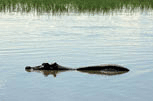

 In June 2012 I had the great pleasure of taking my grandchildren to Disney World. In spite of all of the hype and commercialism of Disney, there is always learning available, and always a constant reminder of God's design and wisdom in the world in which we live. One of the parks in the Disney World complex in Florida is the Animal Kingdom® Theme Park where a great deal of information is available about how animals live and survive in the natural world. We took the safari ride in which the humans are in an “open-sided safari vehicle” and the animals are running free in a natural setting. We went through an area where hippopotamuses were in a river, and the guide was explaining that a particular hippo we were looking at was sound asleep. About the time she said that, the hippo rose and exhaled, blowing a blast of air and water droplets into the air, and then the animal submerged again. “I thought you said he was asleep,” one child said to the guide. “He is,” said the guide. “They do that in their sleep.”
In June 2012 I had the great pleasure of taking my grandchildren to Disney World. In spite of all of the hype and commercialism of Disney, there is always learning available, and always a constant reminder of God's design and wisdom in the world in which we live. One of the parks in the Disney World complex in Florida is the Animal Kingdom® Theme Park where a great deal of information is available about how animals live and survive in the natural world. We took the safari ride in which the humans are in an “open-sided safari vehicle” and the animals are running free in a natural setting. We went through an area where hippopotamuses were in a river, and the guide was explaining that a particular hippo we were looking at was sound asleep. About the time she said that, the hippo rose and exhaled, blowing a blast of air and water droplets into the air, and then the animal submerged again. “I thought you said he was asleep,” one child said to the guide. “He is,” said the guide. “They do that in their sleep.”
While the child seemed unconvinced, it reminded me of how many autonomic systems there are in living things. You do not have to think to breathe. The autonomic system is part of our hard-wired system connecting our brain to various body functions that are carried on without our thinking about them. In our own bodies there are many autonomic systems connected with digestion, respiration, salivation, perspiration, pupillary dilation, and the like. In humans we know that these systems are located in the medula oblongata, and they are divided into three control centers — the respiratory center, the cardiac center, and the vasomotor center. These are further subdivided into different systems and controls so that our bodies run without our having to think about all of these functions.
In the case of the hippo, the design of the animal's buoyancy, the location of its nostrils, and the timing sense it has allow it to breathe, hold its breath, and then breath again autonomically. This is a wonderfully designed system, peculiar to the needs of this animal. Ours too is suited to our needs — we are fearfully and wonderfully made (Psalm 139:14).
Picture credits:
© Jessica Bethke. Image from BigStockPhoto.com
